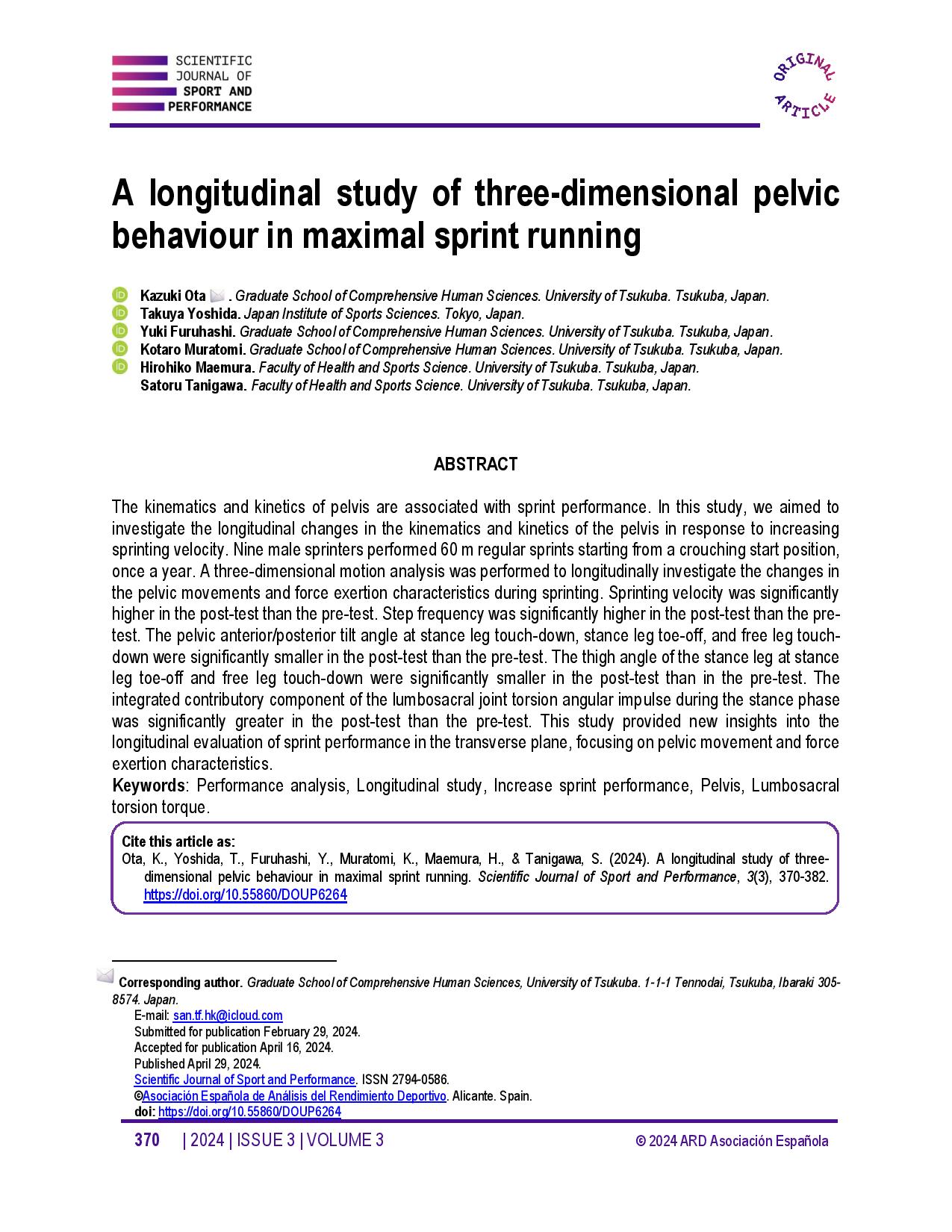A longitudinal study of three-dimensional pelvic behaviour in maximal sprint running
Main Article Content
Abstract
The kinematics and kinetics of pelvis are associated with sprint performance. In this study, we aimed to investigate the longitudinal changes in the kinematics and kinetics of the pelvis in response to increasing sprinting velocity. Nine male sprinters performed 60 m regular sprints starting from a crouching start position, once a year. A three-dimensional motion analysis was performed to longitudinally investigate the changes in the pelvic movements and force exertion characteristics during sprinting. Sprinting velocity was significantly higher in the post-test than the pre-test. Step frequency was significantly higher in the post-test than the pre-test. The pelvic anterior/posterior tilt angle at stance leg touch-down, stance leg toe-off, and free leg touch-down were significantly smaller in the post-test than the pre-test. The thigh angle of the stance leg at stance leg toe-off and free leg touch-down were significantly smaller in the post-test than in the pre-test. The integrated contributory component of the lumbosacral joint torsion angular impulse during the stance phase was significantly greater in the post-test than the pre-test. This study provided new insights into the longitudinal evaluation of sprint performance in the transverse plane, focusing on pelvic movement and force exertion characteristics.
Article Details

This work is licensed under a Creative Commons Attribution-NonCommercial-ShareAlike 4.0 International License.
References
Bruggrmann, GP., Glad, B. (1990). Time analysis of sprint events. Scientific research. project at the games of the XIVth Olympiad - Seoul 1988. New Studies in Athletics, 5 (Supplement).
Chapman, AE., Caldwell, GE. (1983). Factors determining changes in lower limb. energy during swing in treadmill running. Journal of Biomechanics, 16: 69-77. https://doi.org/10.1016/0021-9290(83)90047-7 DOI: https://doi.org/10.1016/0021-9290(83)90047-7
Clark, K., Meng, C., Stearne, D. (2020). 'Whip from the hip': thigh angular motion, ground contact mechanics, and running speed. Biology Open, 9(10): bio053546. https://doi.org/10.1242/bio.053546 DOI: https://doi.org/10.1242/bio.053546
Cohen, J. (1992). A power primer, Psychol Bull, 112: 155-159. https://doi.org/10.1037//0033-2909.112.1.155 DOI: https://doi.org/10.1037//0033-2909.112.1.155
Dumas, R., Cheze, L., Verriest, JP. (2007a). Adjustments to McConville et al. and. Young et al. body segment inertial parameters. Journal of biomechanics, 40(3): 543-553. https://doi.org/10.1016/j.jbiomech.2006.02.013 DOI: https://doi.org/10.1016/j.jbiomech.2006.02.013
Dumas, R., Cheze, L., Verriest, JP. (2007b). Corrigendum to adjustments to. McConville et al. and Young et al. body segment inertial parameters. Journal of Biomechanics, 40(7): 1651-1652. https://doi.org/10.1016/j.jbiomech.2006.07.016 DOI: https://doi.org/10.1016/j.jbiomech.2006.07.016
Field, A. (2005). Discovering statistics using SPSS (and sex, drugs and rock 'n' roll) (2nd ed.). London: Sage.
Franz, JR., Paylo, KW., Dicharry, J., Riley, PO., Kerrigan, DC. (2009). Changes in the coordination of hip and pelvis kinematics with mode of locomotion. Gait & posture, 29(3): 494-498. https://doi.org/10.1016/j.gaitpost.2008.11.011 DOI: https://doi.org/10.1016/j.gaitpost.2008.11.011
Grood, ES., Suntay, WJ. (1983). A joint coordinate system for the clinical. description of three-dimensional motions: application to the knee. Journal of biomechanical engineering, 105(2): 136-144. https://doi.org/10.1115/1.3138397 DOI: https://doi.org/10.1115/1.3138397
Haralabidis, N., Colyer, SL., Serrancolí, G., Salo, AI., Cazzola, D. (2022). Modifications to the net knee moments lead to the greatest improvements in accelerative sprinting performance: a predictive simulation study. Scientific reports, 12(1): 1-18. https://doi.org/10.1038/s41598-022-20023-y DOI: https://doi.org/10.1038/s41598-022-20023-y
Hay, JG. (1993). Track and field: running. The biomechanics of sports techniques. Fourth Edition. Upper Saddle River: Prentice Hall, 396-411.
Hunter, JP., Marshall, RN., McNair, PJ. (2005). Relationships between ground. reaction force impulse and kinematics of sprint-running acceleration. Journal of applied biomechanics, 21(1): 31-43. https://doi.org/10.1123/jab.21.1.31 DOI: https://doi.org/10.1123/jab.21.1.31
Ito, A., Fukuda, K., Kijima, K. (2007). Mid-phase movements of Tyson Gay and Asafa Powell in the 100 metres at the 2007 World Championships in Athletics. N Stud Athletics, 23: 39-43.
Mann, RV., Murphy, A. (2015). The mechanics of sprinting and hurdling.
Mattes, K., Habermann, N., Schaffert, N., Mühlbach, T. (2014). A longitudinal study of kinematic stride characteristics in maximal sprint running. Journal of human sport and exercise, 9(3): 686-699. https://doi.org/10.14198/jhse.2014.93.02 DOI: https://doi.org/10.14198/jhse.2014.93.02
Mendiguchia, J., Castaño-Zambudio, A., Jiménez-Reyes, P., Morin, JB., Edouard, P., Conceição, F., Tawiah-Dodoo, J., Colyer, SL. (2022). Can We Modify Maximal Speed Running Posture? Implications for Performance and Hamstring Injury Management. Int J Sports Physiol Perform, 17(3): 374-383. https://doi.org/10.1123/ijspp.2021-0107 DOI: https://doi.org/10.1123/ijspp.2021-0107
Nagahara, R., Zushi, K. (2013). Determination of foot strike and toe-off event. timing during maximal sprint using kinematic data. International Journal of Sport and Health Science, 11: 96-100. https://doi.org/10.5432/ijshs.201318 DOI: https://doi.org/10.5432/ijshs.201318
Nagano, Y., Higashihara, A., Takahashi, K., Fukubayashi, T. (2014). Mechanics of the muscles crossing the hip joint during sprint running. Journal of sports sciences, 32(18): 1722-1728. https://doi.org/10.1080/02640414.2014.915423 DOI: https://doi.org/10.1080/02640414.2014.915423
Novacheck, TF. (1998). The biomechanics of running. Gait and Posture, 7: 77-95. https://doi.org/10.1016/S0966-6362(97)00038-6 DOI: https://doi.org/10.1016/S0966-6362(97)00038-6
Ota, K., Yoshida, T., Ono, K., Maemura, H., and Tanigawa, S. (2022). Relationships between pelvic behavior and ground reaction force as well as leg swing velocity during the acceleration. 67, 793–808. https://doi.org/10.5432/jjpehss.21096 DOI: https://doi.org/10.5432/jjpehss.21096
Preece, SJ., Mason, D., Bramah, C. (2016). The coordinated movement of the spine and pelvis during running. Human Movement Science, 45: 110-118. https://doi.org/10.1016/j.humov.2015.11.014 DOI: https://doi.org/10.1016/j.humov.2015.11.014
Reed, MP., Manary, MA., Schneider, LW. (1999). Methods for measuring and. representing automobile occupant posture. SAE Technical Paper Series: 1999-01-0959, Society of Automobile Engineers, Warrendale, USA. https://doi.org/10.4271/1999-01-0959 DOI: https://doi.org/10.4271/1999-01-0959
Sado, N., Yoshioka, S., Fukashiro, S. (2016). Kinetics study of the pelvic elevation/drop during maximal sprint running. Tokyo society of physical education health and sport science, 8: 13-19. (in Japanese)
Sado, N., Yoshioka, S., Fukashiro, S. (2017). The three-dimensional kinetic. behaviour of the pelvic rotation in maximal sprint running. Sports Biomechanics, 16: 258-271. https://doi.org/10.1080/14763141.2016.1231837 DOI: https://doi.org/10.1080/14763141.2016.1231837
Wells, RP., Winter, DA. (1980). Assessment of signals and noise in normal, pathological, and sports gait. Proc Special Conf Can Soc Biomech London Canada, 92-93.
Winter, DA. (2009). Biomechanics and motor control of human movement. John Wiley. & Sons. https://doi.org/10.1002/9780470549148 DOI: https://doi.org/10.1002/9780470549148
Wu, G., Siegler, S., Allard, P., Kirtley, C., Leardini, A., Rosenbaum, D., Whittle, M., D'Lima, DD., Cristofolini, L., Witte, H., Schmid, O., Stokes, I. (2002). ISB recommendation on definitions of joint coordinate system of various joints for the reporting of human joint motion-part I: ankle, hip, and spine. Journal of biomechanics, 35(4): 543-548. https://doi.org/10.1016/S0021-9290(01)00222-6 DOI: https://doi.org/10.1016/S0021-9290(01)00222-6




